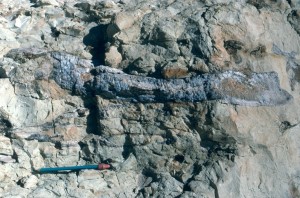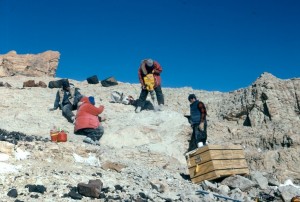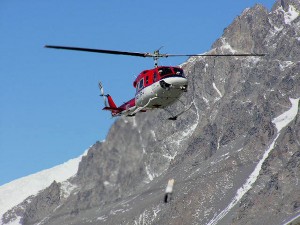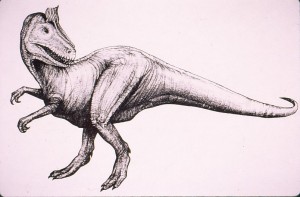David Elliot has had a distinguished career as a geologist at Ohio State University. So some are surprised when they learn that he discovered an unknown dinosaur species in Antarctica. And it’s named for him! Retired from teaching duties at the university, David currently is an emeritus professor and continues his research, which has revealed so much about the polar past.
Researcher name: David Elliot
University/Organization: Byrd Polar Research Center at Ohio State University
Research Location: Antarctica
Finding Land Under the Ice
This research story takes place in the Transantarctic Mountains, which stretch across the continent of Antarctica. These mountains separate the ice sheet in Antarctica into two distinct regions. The East Antarctic Ice Sheet (EAIS) is a large mass of land-based ice more than a mile thick. The West Antarctic Ice Sheet (WAIS) is covered by thinner ice, some of which is over water. In fact, some of the ice in the WAIS is actually below sea level.
Geologically, the land underlying the EAIS is a stable, old part of the continent’s crust, called a craton, while the land areas under the WAIS have been described as a “collage” of blocks (of continental crust) and basins. If the WAIS could be seen without its covering of ice, it would look like an area of mountainous islands. News reports of rapid changes in Antarctica usually refer to the WAIS, which is showing more rapid response to climate change than the EAIS.
While the changes in the distribution and thickness of the ice in Antarctica are of high interest right now, researchers continue to study the landforms (including the Transantarctic Mountains) to help explain the history of the continent. In 1990, David’s research group was working in the central part of the Transantarctic Mountains on a series of rocks that were formed during the Jurassic period, approximately 199 million to 145 million years ago.
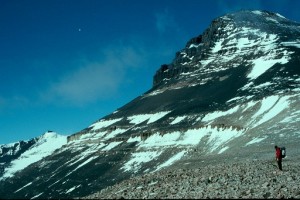
The complete volcanic sequence exposed at Mt. Falla (close to the site of the dinosaur discovery). Black cliff-forming strata are lava, whereas the underlying lighter colored strata are silicic volcanic strata. Photo courtesy of David Elliot.
David’s group was measuring the layers, making sketches, taking notes, and collecting and marking samples of the rocks. They were looking for evidence that would help to identify when volcanic eruptions began and how many times they had occurred.
The lower assemblage of rocks is a series of sandstones and ash beds, and some “re-worked ash.” David’s trained eye could see the “tricuspate shards” that are evidence of bubbles in the lava. He said, “Think of it like the space between one marble that’s stacked on three marbles.” It was the particle shape that identified that particular type of violent volcanic activity.
An Unexpected Find
On the day he discovered the dinosaur, David went for a walk after lunch, as he usually did. As he went around a rock outcrop, he noticed some large objects embedded in the rock. “It took awhile for the penny to drop,” he said. He looked more closely and thought, “They must be bones!” One of the bones was shaped like a femur, and others were flat and curved, which he thought meant that they must be ribs. Some looked like giant knuckle bones, and then David saw the jaw and eye socket of the head in the outcrop. (Keep in mind that it is uncommon to find vertebrates in Antarctica, let alone big ones!)
David’s group was one of eight research teams working in that part of Antarctica at the time; they shared helicopter support and a base camp. As a result, the teams knew each others’ research interests. David called paleontologist Bill Hammer, who was working far below on the same mountain. Bill is a geology professor at Augustana College in Rock Island, Illinois, where he is well known for his fossil-finding expeditions to Antarctica.
The next day a helicopter brought Bill upslope. As David approached the helicopter, he held one of the bone fragments behind his back. As soon as Bill saw the fragment, he confirmed that it was indeed a bone from a very large reptile. When he saw the rest of the skeleton embedded in the rock, he knew it was a dinosaur. Three-fourths of the skull was intact. The snout had been worn away at an angle, so the skeleton was incomplete. But it was an excellent specimen!
Bill requested helicopter support to move his entire camp up to David’s site the next day. For the rest of the field season, Bill’s team used jackhammers to break the rock around the skeleton so that it could be transported to the United States and “cleaned up.” Because the skeleton was embedded in rock at an elevation of more than 13,000 feet, the pilots needed to carefully estimate the weight of the sling loads or they would not be able to lift them off the ground.
For the next three years, back in Illinois, Bill’s group cleaned, measured, and reassembled the skeleton. The 22-foot-long, meat-eating crested dinosaur has since been named Cryolophosaurus ellioti. The genus name, Cryolophosaurus (pronounced: cry o loff‘ o sore us), means “cold crest lizard,” or “frozen crested reptile,” and the species name, ellioti, is a tribute to the person who discovered the fossil, David Elliot.
Among the large bones of the dinosaur skeleton, there were other bones and bone fragments from smaller animals that fed on the carcass of the large dinosaur, including a group of dinosaurs known as theropods. The fearsome Tyrannosaurus rex was a theropod. Evidence collected from the sediments around the bones and from plant remains that were also found nearby led Bill and his research group to conclude that the climate at the time Cryolophosaurus was alive was cool, like modern-day Washington state, but not as wet. In 1994, David and Bill presented their findings at a conference, where they described the indicators of past climate (paleoclimate) that became evident from this excavation.
David has continued to interpret the volcanic layers of the central Transantarctic Mountain region. He and his colleagues have helped to explain some of the changes in the Antarctic continent at the time of the breakup of Gondwana (a part of the previous supercontinent Pangaea). In 1996, David proposed a new name, the Hanson Formation, for the upper, volcanic part of the rock sequence that he had been studying in 1990 at the time of the “find.”
In 2006, David organized a multidisciplinary workshop at Byrd Polar Research Center for scientists interested in studying the central Transantarctic Mountains. He continues to work with the operation and development of the U.S. Polar Rock Repository, which houses rock samples from Antarctica, the Arctic, southern South America, and South Africa.
The International Polar Year will no doubt result in many more discoveries and improved understandings of the geologic and climatic history of Antarctica. Researchers from many countries are collaborating to refine what we already understand about the past and the present conditions of the polar regions, and to improve the models that help to predict what may happen in the future.
This article was written by Carol Landis. For more information, see the Contributors page. Email Kimberly Lightle, Principal Investigator, with any questions about the content of this site.
Copyright April 2008 – The Ohio State University. This material is based upon work supported by the National Science Foundation under Grant No. 0733024. Any opinions, findings, and conclusions or recommendations expressed in this material are those of the author(s) and do not necessarily reflect the views of the National Science Foundation. This work is licensed under an Attribution-ShareAlike 3.0 Unported Creative Commons license.


